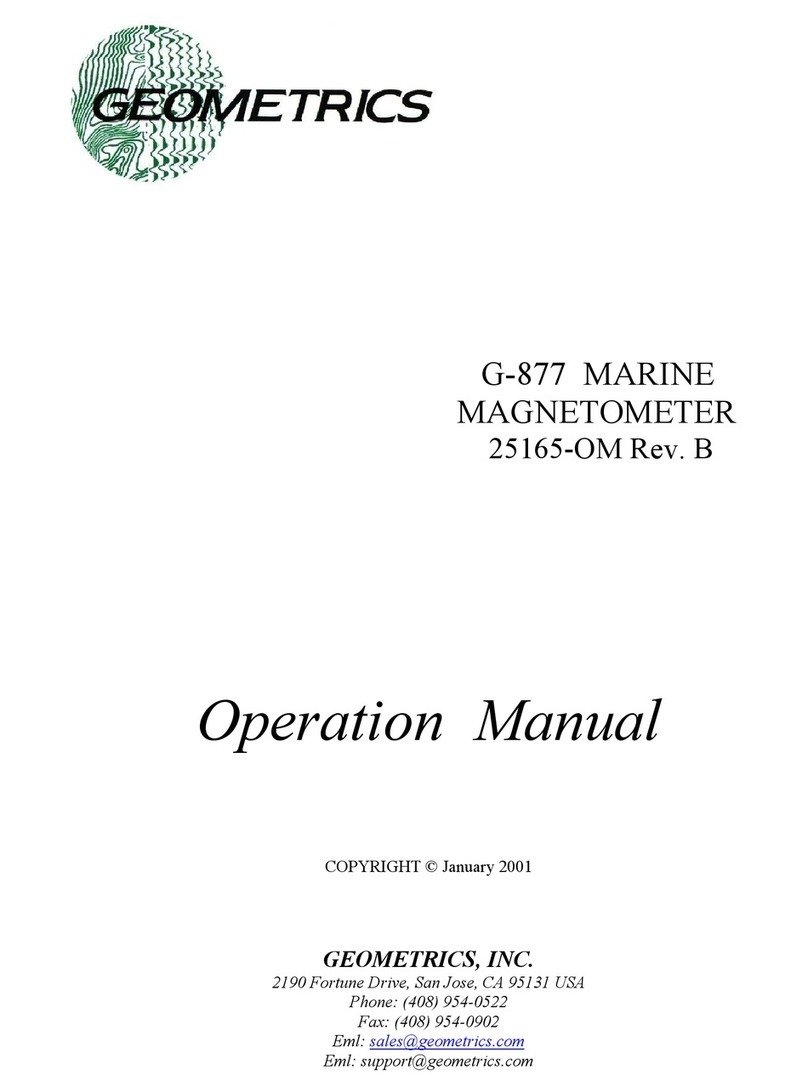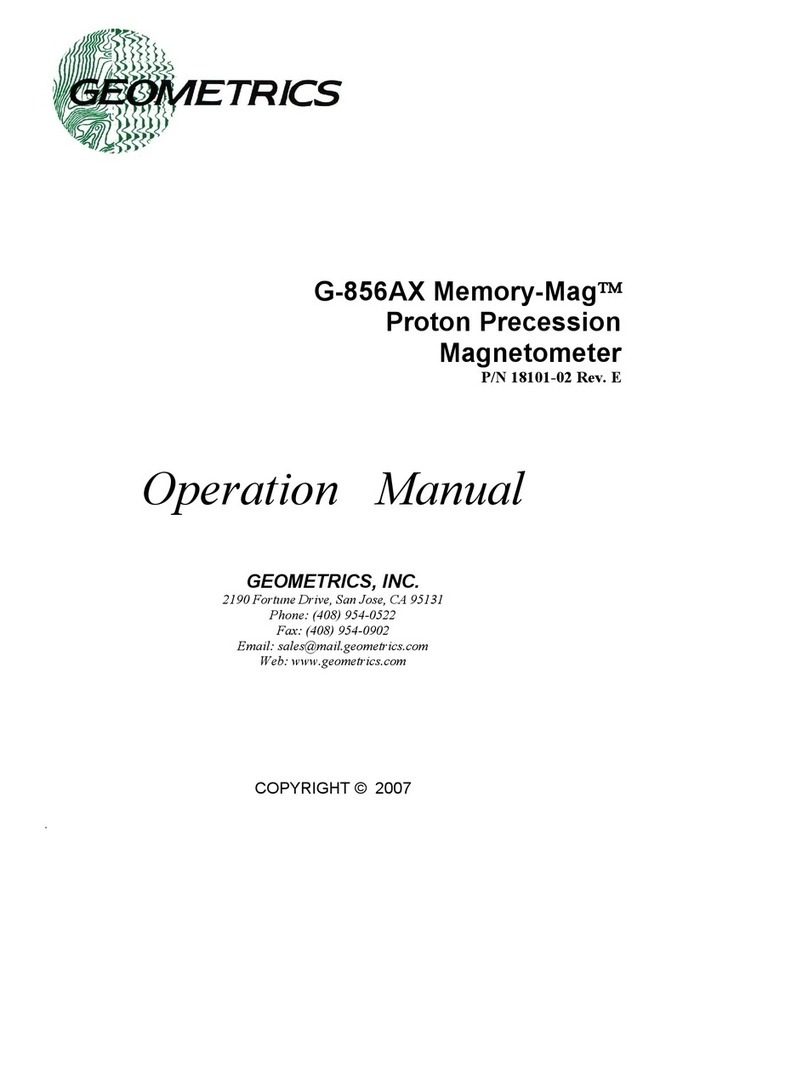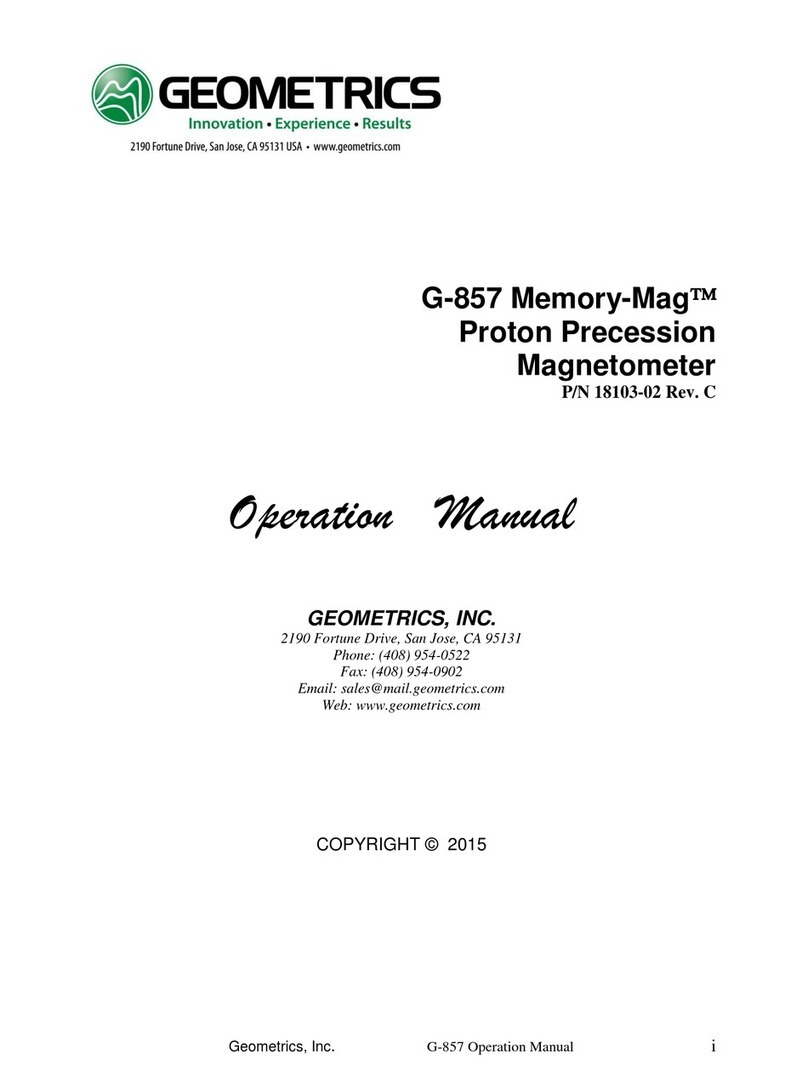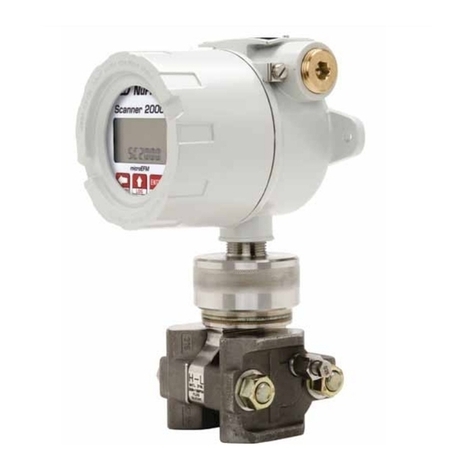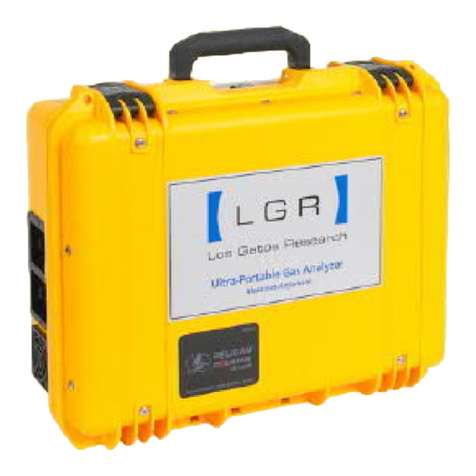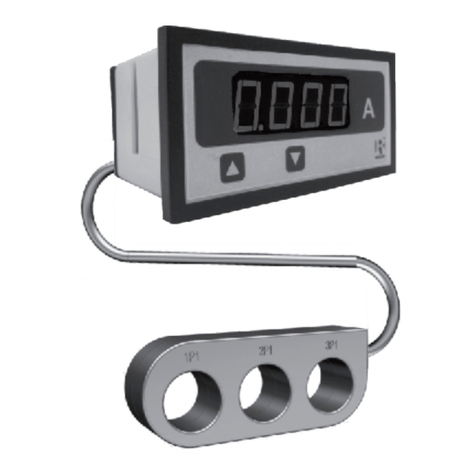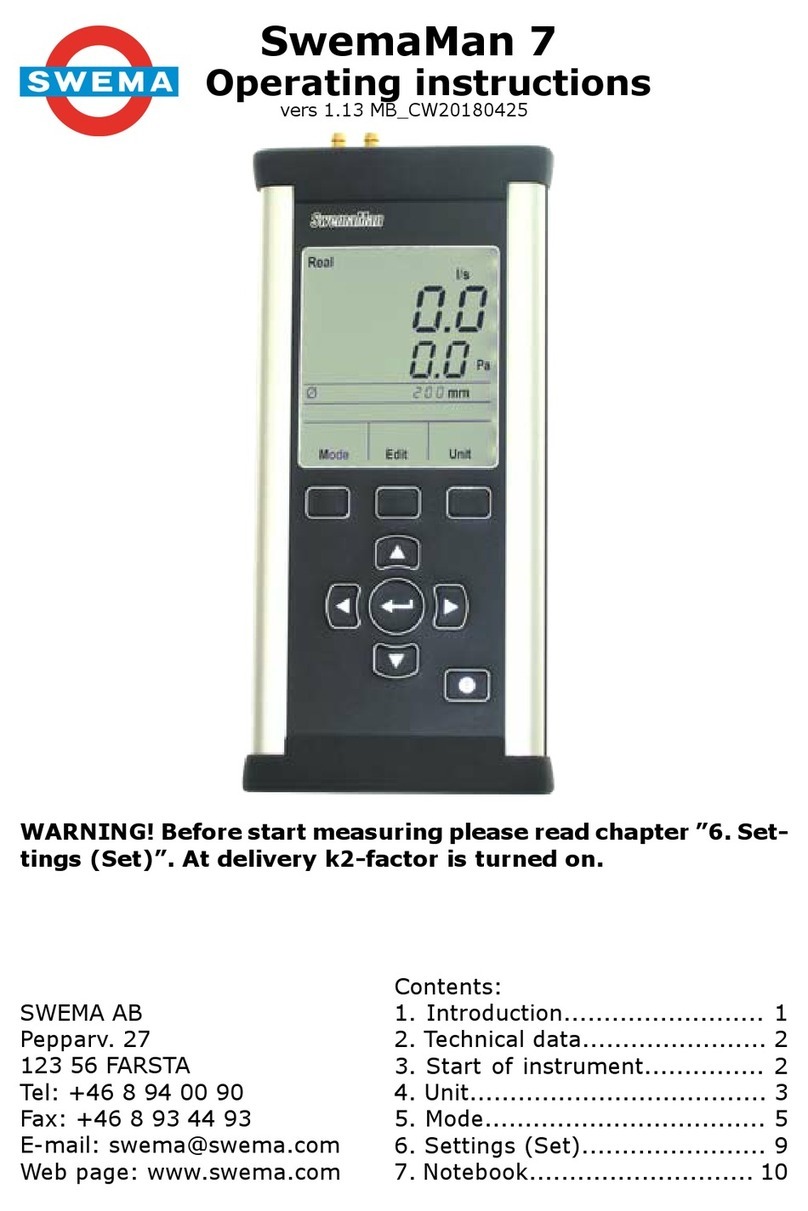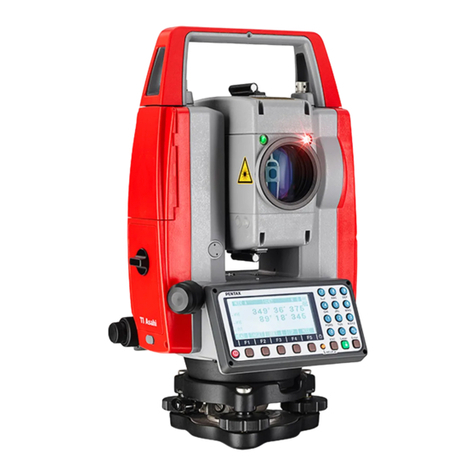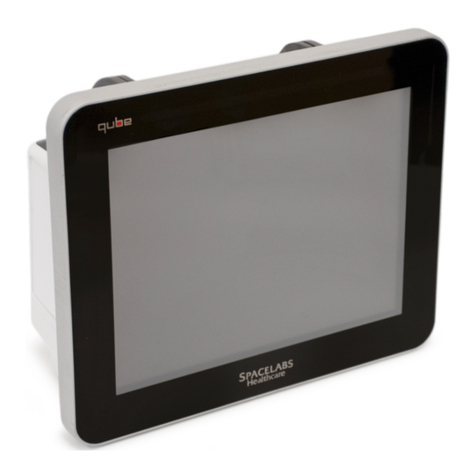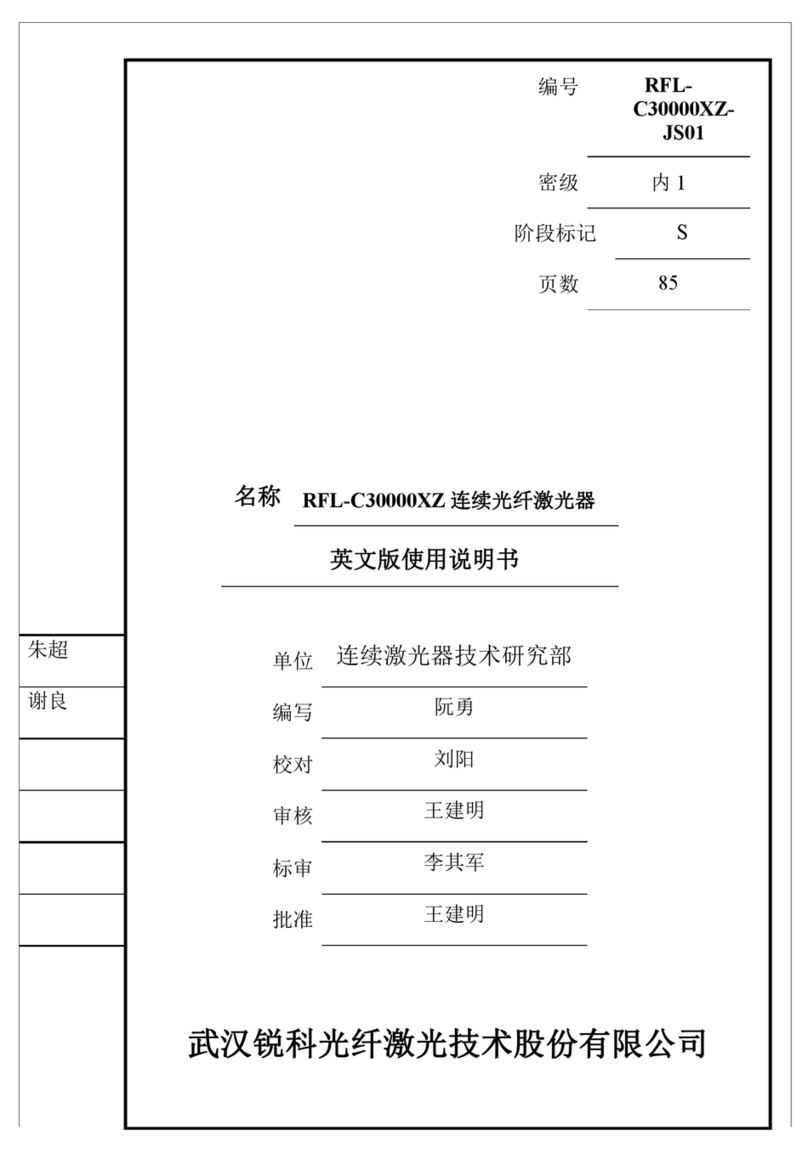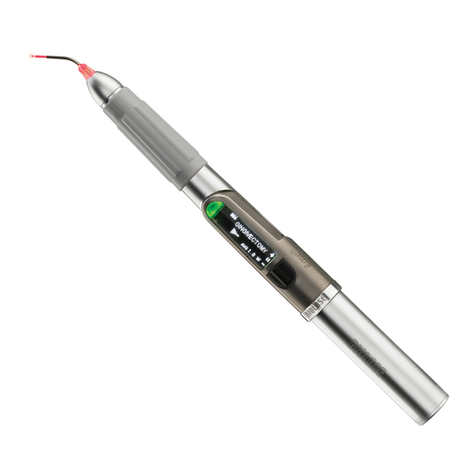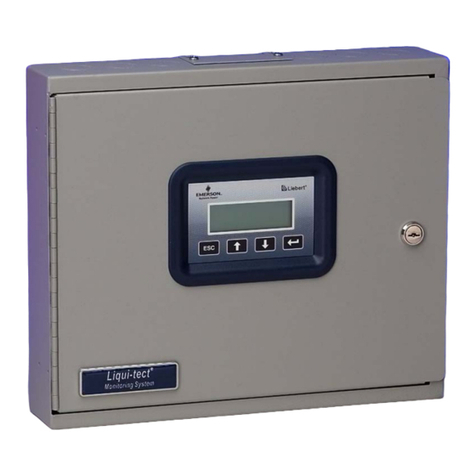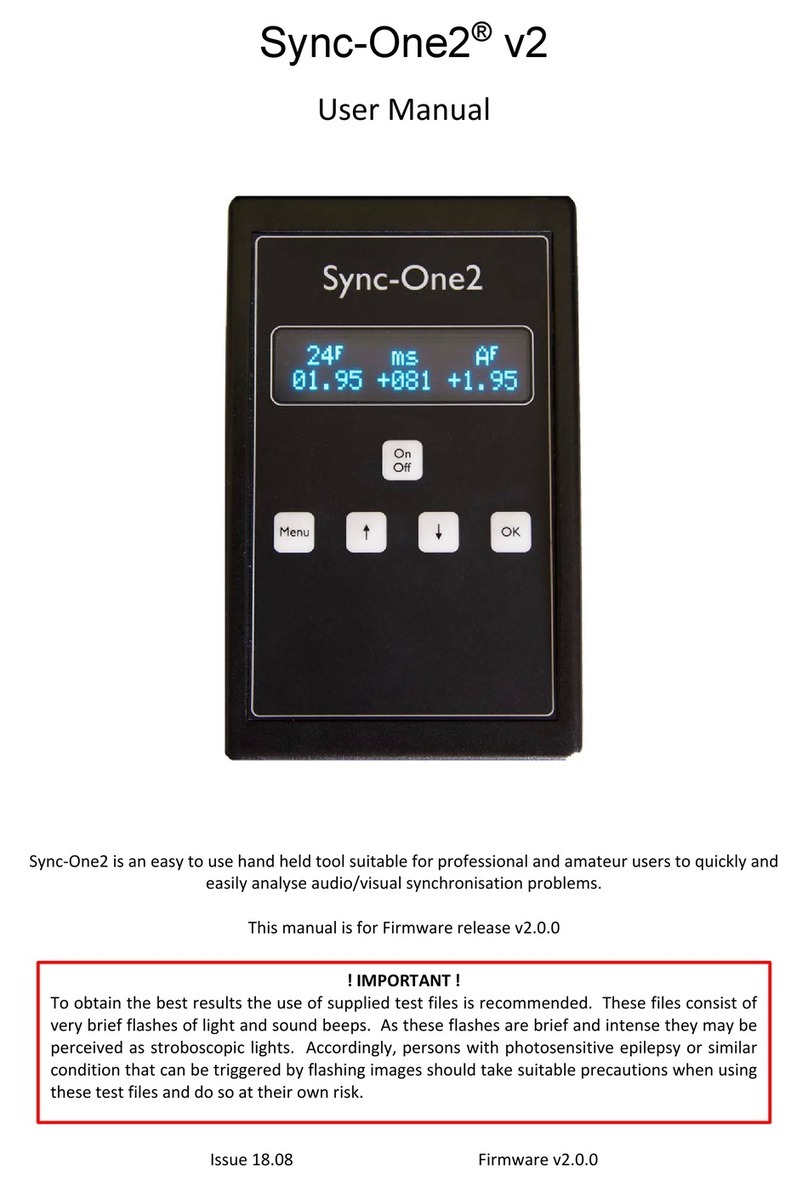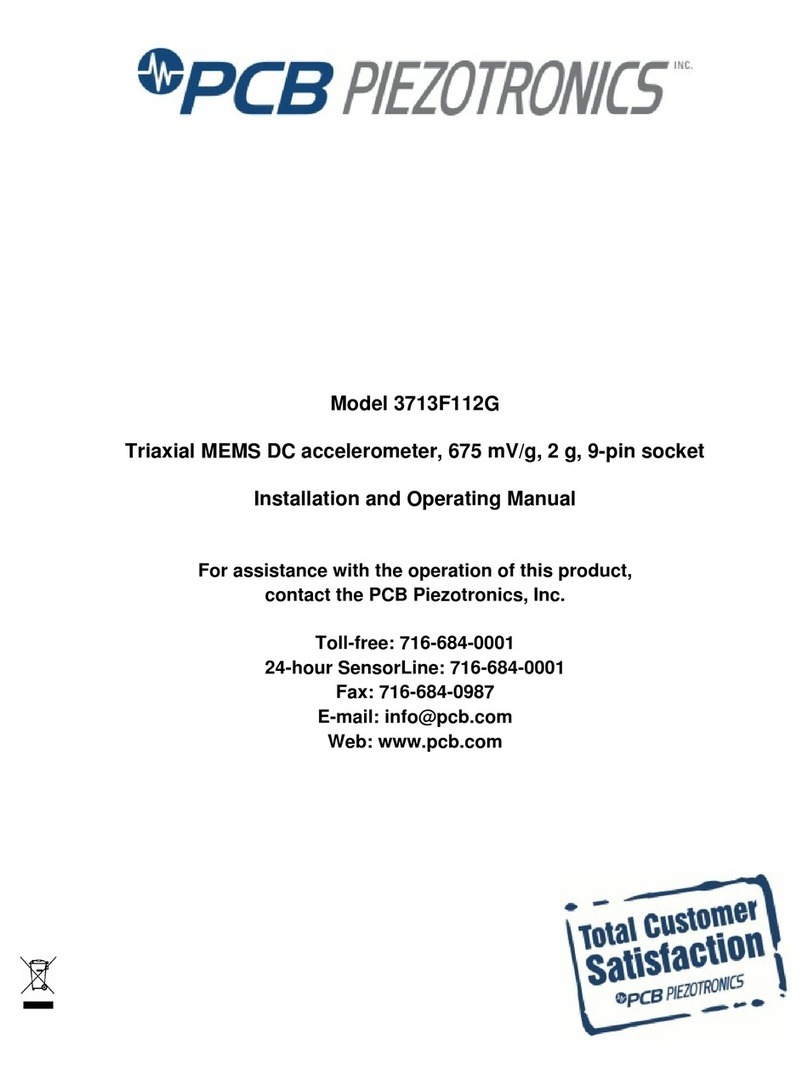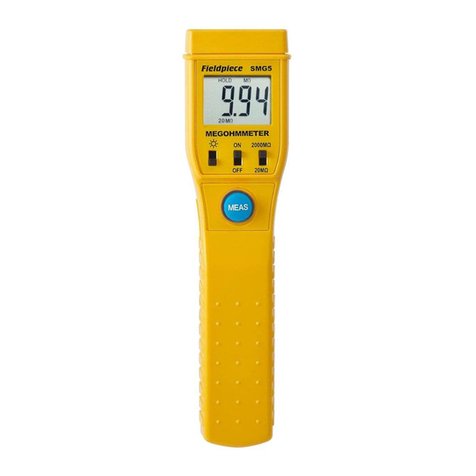Geometrics G-824A User manual

G-824A CESIUM MAGNETOMETER
Operation Manual
COPYRIGHT © 2014
P/N 27731-OM
Revision A7
GEOMETRICS, INC.
2190 Fortune Drive, San Jose, CA 95131 USA
Phone: (408) 954-0522
Fax: (408) 954-0902
EMAIL: [email protected]m

ii

Geometrics, Inc. G-824 Magnetometer Manual
iii
TABLE OF CONTENTS
1.0 INTRODUCTION...............................................................................................................1
2.0 SYSTEM COMPONENTS..................................................................................................2
3.0 PERFORMANCE ...............................................................................................................4
4.0 INSTALLATION .................................................................................................................5
4.1 Sensor orientation.........................................................................................................................................................6
4.2 Sensor attachment ......................................................................................................................................................11
Vibration........................................................................................................................................................................12
Electronic/electromagnetic ............................................................................................................................................12
Temperature...................................................................................................................................................................13
5.0 OPERATION....................................................................................................................13
6.0 TROUBLE SHOOTING....................................................................................................13
7.0 G-824A MAGNETOMETER.............................................................................................15
7.1 CM-321 Output Format.............................................................................................................................................17
7.2 Installing Driver for USB to Serial Converter ........................................................................................................21
7.2.1 Configuring the FTDI Driver...............................................................................................................................21
7.2.2 Installing Tera Term Terminal Emulator.............................................................................................................24
7.2.3 Serial Data Interface ............................................................................................................................................25
7.3 Detailed configuration descriptions:.........................................................................................................................25
7.3.1 Tera Term, Terminal Emulator Program Setup ...................................................................................................25
7.3.2 ASCII Data Output Format with 250 Hz Output Rate Configuration Example...................................................27
7.3.3 SET CYCLE TIME (Data Output Rate)...............................................................................................................28
7.3.4 SET FORMAT OUTPUT OF DATA...................................................................................................................29
7.3.5 SAVING SETTINGS IN MEMORY ...................................................................................................................32
7.3.6 START G-824A DATA TRANSMISSION .........................................................................................................33
7.3.7 Setting the Power Up Mode:..................................................................................................................................33
7.3.8 XS3 Data Output Format with 1000 Hz Output Rate Example ...........................................................................34
7.3.9 PPS Synchronization...........................................................................................................................................38
7.3.10 Magnetometer Operational Status.....................................................................................................................39
7.4 XS3 Data Output Format..........................................................................................................................................40
7.5 G-824A Warm-up Time...........................................................................................................................................41
7.6 Power-up Initialization..............................................................................................................................................41
7.7 Hemisphere Locking Switch......................................................................................................................................41

Geometrics, Inc. G-824 Magnetometer Manual
iv
8.0 G-824B MAGNETOMETER.............................................................................................42
9.0 ACCESSORY SOFTWARE ............................................................................................43
9.1 Cesium Sensor Azimuth Program - CsAz .............................................................................................................44
APPENDIX A1. MODEL G-824A SPECIFICATIONS ............................................................45
APPENDIX A2. MODEL G-824B SPECIFICATIONS ............................................................46
APPENDIX A3. SENSOR INSTALLATIONS.........................................................................47
APPENDIX A4. CESIUM-VAPOR SENSOR THEORY..........................................................52
APPENDIX A.6 G-824A GENERAL BLOCK DIAGRAM OF SYSTEM COMPONENTS.......56
APPENDIX A.7 G-824B GENERAL BLOCK DIAGRAM OF SYSTEM COMPONENTS.......57
LIST OF FIGURES AND TABLES
FIGURE 1SENSOR,SENSOR CABLE AND SENSOR DRIVER MODULE............................................................2
FIGURE 2G-824 SYSTEM AND ACCESSORIES............................................................................................3
FIGURE 3ACTIVE ZONE FOR THE CESIUM-VAPOR SENSOR..........................................................................4
FIGURE 4SHOWING INCLINATION OF EARTH'S MAGNETIC FIELD ...............................................................5
FIGURE 5MAGNETIC FIELD INTENSITY AT THE EARTH'S SURFACE............................................................6
FIGURE 6MID-LATITUDE ZONE.................................................................................................................8
FIGURE 7POLAR ZONE SENSOR ORIENTATION ..........................................................................................9
FIGURE 8EQUATORIAL LATITUDE...........................................................................................................10
FIGURE 9SENSOR MOUNT THAT PROVIDES FOR TWO AXES OF ADJUSTMENT.P/N 27530-04...................11
FIGURE 10 BLOCK DIAGRAM OF G-824, POWER,PPS, AND COMPUTER CONNECTIONS ...........................18
FIGURE 11. SCHEMATIC DIAGRAM OF DAISY-CHAINED CM-321COUNTER MODULES.................................20
FIGURE 12. WIRING DIAGRAM OF INTERFACE CABLE................................................................................20
TABLE 1. G-824A STANDARD COMPONENT WEIGHTS AND DIMENSIONS ....................................................3
TABLE 2. TROUBLE SHOOTING.................................................................................................................13
TABLE 3. G-824A STANDARD COMPONENT WEIGHTS AND DIMENSIONS ..................................................15
TABLE 4. G-824A INTERFACE CABLE PIN-OUT.........................................................................................15
TABLE 5. EXAMPLE OF CM-321 DEFAULT OUTPUT DATA STREAM...........................................................19

Geometrics, Inc. G-824A Magnetometer Manual
1
1.0 INTRODUCTION
Congratulations on your purchase or rental of one of the finest cesium vapor
magnetometers ever produced. This manual will provide you with an understanding of
alkali vapor magnetometer technology and will give you instructions for installing the
system for airborne, land or marine use. It is not meant to be exhaustive for every case as
there are many situations and applications in which magnetometers can be used. Please
contact the factory if you have specific questions relating to your application.
The Geometrics G-824 magnetometer employs an optically pumped Cesium-vapor
atomic magnetic resonance system that functions as the frequency control element in an
oscillator circuit. The G-824 contains counter circuitry that internally converts the
magnetometer’s analog signal into a digital RS−232 output.
The frequency of the magnetometer electrical oscillator is known as the Larmor
frequency and it varies directly with the ambient magnetic field at the sensor (white
cylinder shown in Fig. 1). When this frequency is accurately measured it provides an
extremely precise measurement of the earth’s total magnetic field (better than 1 part in
108). The design of the sensor optical package uses a split-beam design which eliminates
the need to optimize sensor orientation to obtain precise measurements.
As shown in Figure 1, the G-824 magnetometer consists of two interconnected modules:
a sensor module and sensor driver module. The G-824 relies on counter circuitry that is
internal to the sensor driver module using the Geometrics CM-321 SupremaC counter.
Due to licensing concerns we do not offer the G-824 with analog Larmor output for
external counting at this time. The system comes with a sensor, sensor driver module
with counter, power/data cable (25 feet or 7.6 m), and an RS-232 output cable in a rugged
shipping case. Optional accessories include MagLog logging software, power/data
junction box, USB-Serial convertor, 110/220 VAC 50/60 Hz 28VDC power supply for
lab use, birds, stingers and wing-tip sensor housing aircraft installation kits with internal
orientation platforms.
A basic understanding of the physics employed in the G-824 and optically pumped
resonance magnetometers in general is valuable for troubleshooting new installations and
for achieving optimum results in the field. This information can be found in the Appendix
A4 of this manual.

Geometrics, Inc. G-824A Magnetometer Manual
2
2.0 SYSTEM COMPONENTS
The basic system components of the G-824A consist of the sensor module, a sensor
driver module, and an interconnect cable that is permanently attached to the sensor
module and detachable from the sensor driver module. These components are identified
in Figures 1 and 2. The weights, dimensions, and connector’s specifications for these
components and ancillary system components are listed below in Table 1.
Figure 1 Sensor, sensor cable and Sensor Driver Module

Geometrics, Inc. G-824A Magnetometer Manual
3
Table 1. G-824A standard component weights and dimensions
Description
Weight
Dimensions
Cesium sensor package
P/N 27516-04 (9 ft.) or -21 (14 ft.)
1lb. 8.25 oz.
(0.69 kg.)
2’3/8”x5-1/2” (61.9 cm x 13.97 cm) cylindrical housing with
109” (276.86 cm) or 168” (426.72 cm) cable. Termination:
Burndy 0119 G6JF12-88 PNE
G-824A Sensor driver module
P/N 27735-02
4 lbs. 6.5 oz.
(2 kg.)
18” (45.72 cm) long including connectors.
16”(40.64 cm) long x 2-1/2” (6.35 cm) square housing
Carrying Case
P/N 27750-01
10 lbs.
(4.54 kg.)
18l” x 9.5w” x 15h” (459.74 cm W x 24.13 cm H x 38.1 cm L)
A multi-conductor cable connects the sensor driver module to the junction box and
carries power and digital data from the module. The multi-conductor cable may be as
long as 200ft (61m) for interconnection with a power/data junction box (e.g., Geometrics
Cable P/N 27560-01)
Figure 2 G-824 System and Accessories

Geometrics, Inc. G-824A Magnetometer Manual
4
3.0 PERFORMANCE
Geometrics G-824A magnetometer produces an RS-232 digital data transmission based
on the Cesium Larmor frequency of 3.498572 Hz per nT (nanoTesla). Nano-Tesla refers
to the magnetic field strength also known as one gamma or 10-5 gauss. At the earth’s
surface in a nominal 50,000 nT field the Larmor frequency is about 175 kHz which is
converted using a proprietary counting system in the internal CM-321 SupremaC counter.
The output of the G-824A is an RS-232 transmission at up to 1000 samples per second.
Figure 3 Active zone for the cesium-vapor sensor.
Sensor Active Zone extends from 15º to
75º referenced to the cylindrical axis (for
both hemispheres.)

Geometrics, Inc. G-824A Magnetometer Manual
5
The G-824A is primarily intended for use in airborne and land/ base station applications,
and operates over the earth's magnetic field range of 17,000 to 100,000nT. Absolute
accuracy (as compared to an international standard) is rated at ± 2nT over the earth’s
magnetic field range independent of orientation and does not drift with time. The
accuracy of the internal counter's time base is extremely high and with oversampling
techniques used can give noise levels in the range of 0.4pT/Hz RMS or 10 times better
than the CM-201 counter in the G-823 and G-882. Error due to orientation of the
G-824A does not exceed ±0.3nT or 0.6 nT peak-to-peak (p-p) in spin and tumble
throughout the active zones shown in Figure 3. Environmental conditions for proper
operation are -35 to +50°C (-31 to +122° F), humidity to 99 percent (non-condensing),
and an altitude range of 0 to 30,000 feet.
Like all magnetometers, performance of the G-824A is primarily dependent upon the
counting circuitry employed and the quality of the installation procedures. Compensation
and/or noise reduction techniques must normally be used to minimize the magnetic effect
of the platform (aircraft, UAV or AUV) and its motion. Navigational and positional
errors, radiated electromagnetic noise and heading errors from the aircraft's induced and
remnant magnetic fields are typically the major contributors to noise in the survey results.
4.0 INSTALLATION
The particular installation requirements for each system component must be met in order
to obtain the best performance from the system. It is important to remember that the
sensor driver circuit receives a signal from the sensor whose amplitude is normally one
Figure 4 Showing inclination of earth's magnetic field
Epoch 2000, 2º contour interval.

Geometrics, Inc. G-824A Magnetometer Manual
6
milli-volt as it delivers both heater and lamp oscillator power to the sensor. Anything
that increases the cross-talk between the power and signal circuits or introduces noise
into the power circuit can degrade the sensor output signal and affect system
performance.
4.1 Sensor orientation
Although the G-824A measures the total intensity of the earth’s magnetic field, magnetic
fields in general are vector fields. The total field is the sum of the three components as
projected onto the earth’s field vector which is roughly vertical at the poles and
horizontal at the magnetic equator. At any point the field is defined by its magnitude and
direction. Unless the sensor is very near highly magnetic objects, the local magnetic field
will be almost entirely due to the earth’s magnetic field. In order for the G-824A to
accurately measure the local magnetic field magnitude, it must be properly oriented
relative to the local magnetic field direction.
The sensor head must be oriented so that the local field flux vector impinges at an angle
of from 15º to 75º to the cylindrical axis of the sensor, for all platform attitudes
encountered during survey. Alignments that produce a field/axis angle less than 15º
place the magnetic field within the sensor’s "polar dead zone". Similarly, alignments that
produce a field/axis angle greater than 75º place the magnetic field within the sensor’s
Figure 5 Magnetic field intensity at the Earth's surface.
Epoch 2000, 1000 nT contour interval.

Geometrics, Inc. G-824A Magnetometer Manual
7
"equatorial dead zone". The sensor will not produce usable data when the angle between
the earth's field and the cylindrical axis falls within one of these two zones. So, in
latitudes where the inclination of the earth's field vector is 45º, vertical orientation of the
sensor’s axis will allow operation in all flight attitudes and directions. In equatorial
regions it may be necessary to orient the sensor at a 45º (for E-W flight direction) or
horizontally and at an angle to the flight path (NW-SE, NE-SW). In polar regions the
sensor may be mounted with its major axis tilted at 45º in any direction to obtain the
desired angle for omnidirectional survey.
The maps in Figures 4 and 5 may be used to determine the inclination and total intensity
of the Earth's magnetic field in the intended area of survey. This inclination information
should be used to adjust the sensor orientation for the best performance in the survey
area. The intensity information may be used as a check of the system operation.
Geometrics also offers a program called CSAZ which is available for download from our
website (Magnetometers, Downloads, Software) and on the supplied Magnetometer CD.
CSAZ calculates the proper sensor orientation for all positions and survey directions and
shows the optimum sensor orientation. It also calculates the total field, inclination (tilt or
dip) and declination (offset between magnetic north and geographic north) for every
latitude and longitude position on the earth’s surface. Go to www.geometrics.com for
more information.
In regard to sensor orientation, the Earth’s surface can be divided into three zones based
on magnetic field inclination: mid-latitude, equatorial, and polar. Within each of these
zones there is a particular sensor orientation that will yield optimum signal strength over
the entire zone. These regions and the corresponding sensor orientations recommended
for each region are shown in Figures 6 through 8.

Geometrics, Inc. G-824A Magnetometer Manual
8
Note that the orientation zones show in Figures 6 through 8 overlap one another by 10º of
magnetic inclination. In these regions of overlap either of the recommend orientations
may be used. Also, note that in the equatorial region there are two different recommended
sensor orientations. In this region the magnetic field is nearly horizontal and there may
be some restrictions on the direction of flight. Choosing one of the two recommended
orientations will allow you to choose flight directions most suitable for your survey area.
Figure 6 Mid-latitude zone.
The diagram to the left shows the
recommended sensor orientation
for operation in mid-latitudes. This
zone is shown as the shaded
regions above and includes those
areas where the absolute
inclination of the Earth’s magnetic
field is greater or equal to 20º and
less than or equal to 75º. There are
no restrictions on the direction of
travel when using this sensor
orientation.

Geometrics, Inc. G-824A Magnetometer Manual
9
The diagram to the left shows the
recommended sensor orientation for
operation in polar latitudes. This zone
is shown as the shaded regions above
and includes those areas where the
absolute inclination of the Earth’s
magnetic field is greater or equal to
65º. There are no restrictions on the
direction of travel when using this
sensor orientation.
Figure 7 Polar Zone sensor orientation

Geometrics, Inc. G-824A Magnetometer Manual
10
The diagram to the left shows the
recommended sensor orientation for
operation in equatorial latitudes.
This zone is shown as the shaded
region above and includes those
areas where the absolute inclination
of the Earth’s magnetic field is less
than or equal to 25º.
There are restrictions on the
direction of flight when using this
sensor orientation in this region. The
bottom diagram to the left shows the
flight directions where the sensor will
produce good signal strength. These
flight directions are 60º wide and are
centered on 45º, 135º, 225º, and 315º.
Normal sensor orientation for
flight in a North-South direction
at the equator will be tilting the
sensor backwards by 45º.
Similarly for East-West flight the
sensor should be tilted to the
North or South by 45º. The
diagram to the left shows an
alternative sensor orientation for
operation in equatorial latitudes.
In this case the sensor is rotated
about its equator by 45º allowing
N-S, E-W survey lines. It includes
those areas where inclination of
the Earth’s magnetic field is less
than 25º.
There are restrictions on the
direction of travel when using this
sensor orientation. The bottom
diagram to the left shows the
flight directions where the sensor
will produce adequate signal.
These flight directions are 600
wide..
Figure 8 Equatorial latitude

Geometrics, Inc. G-824A Magnetometer Manual
11
As noted earlier, we recommend the user use the program CsAz to calculate the sensor’s
operation for a particular inclination and survey direction in your area. This Windows
program is provided on the Magnetometer Support CD supplied with your magnetometer.
4.2 Sensor attachment
An acceptable mount for the G-824A sensor will provide a stable, non-magnetic
attachment to the vehicle, provide vibration dampening and allow the sensor’s orientation
to be adjusted with minimal effort. One example of such a mounting solution is the
sensor mount available from Geometrics (P/N 27530-04). This structure is shown in
Figure 10 below and is designed for attachment inside of a towed bird, a wing pod, or
inside a tail mounted stinger or any circular enclosure with an inside diameter of 7 inches.
Figure 9 Sensor mount that provides for two axes of adjustment. P/N 27530-04.

Geometrics, Inc. G-824A Magnetometer Manual
12
4.2 Environmental Considerations
Optically pumped magnetometers are more sensitive to magnetic field variation than are
proton (Overhauser) and fluxgate types. To realize the full performance of the cesium-
vapor technology, special precautions must be taken during planning and execution of the
installation.
Vibration
The G-824A is usually installed in aircraft and this environment presents particular
challenges. Intense vibration of system circuitry can induce microphonic noise and
shorten the life of system components. For performance and safety considerations the
sensor, sensor driver, and system cabling are normally hard mounted to the aircraft or are
hard mounted in components that are themselves firmly attached to the aircraft in
structures such as stinger and wingtip pods. Some attachments points may be prone to
intense vibration and we recommend the use of good quality shock mounts that are
designed to isolate the G-824A components from as much of the intense vibration as
possible. Special care should be taken in securing or routing the cable so that it does not
encounter hard or sharp objects that could damage the cable. Those components used to
mount the G-824A sensor or any or any objects near this sensor should be non-magnetic
in order to minimize the system heading error.
Electronic/electromagnetic
Sources of performance problems may arise in two areas: external electromagnetic noise
and errors introduced from platform motion. Electrostatic and electromagnetic signals
from aircraft systems, including other sensor instrumentation, can significantly lower the
signal to noise ratio of the magnetometer. An example is the "hash" created by sparking
brushes in certain aircraft generators. This can be seen as a rapidly changing field value
causing excessive scatter in the readings. The permanent, induced and eddy-current
magnetic fields of the airplane can cause significant errors that are dependent on attitude,
acceleration and heading in the earth's magnetic field. The use of a device such as the
RMS Instruments’ Automatic Aeromagnetic Digital Compensator, Geometrics software
program MagComp or fixed passive aero-magnetic compensation techniques will help
reduce these types of errors (See Geometrics technical report TR-15). Variations in
electrical currents in aircraft systems will also cause shifts, bias or increased heading
error in the readings. Consult with Geometrics about the compensation and noise
reduction processes before installation if you are unfamiliar with the procedures used to
minimize noise and platform errors.
G-824A DC power and RS 232 Data pass through a common, non-magnetic,
multiconductor cable. The ground wires of this cable should not be connected to
aircraft/ship ground at any place other than the aircraft battery or the G-824A Junction
Box. We recommend keeping the DC voltage applied to the Sensor Electronics between
24 and 33volts DC for proper operation.

Geometrics, Inc. G-824A Magnetometer Manual
13
Temperature
The G-824A is designed to operate over an ambient temperature range of -35 to +50°C.
In an enclosed region it may be necessary to providing adequate cooling by free flowing
air. If the sensor and electronics are in an unconfined region, convection cooling is
generally adequate. The cesium lamp only needs to dissipate 3 to 4 watts of heat and
when operating in cold regions providing some insulation or baffling around the sensor
will help reduce the sensor’s power consumption and provide faster warm up.
The G-824A requires a minimum warm up period of 15 minutes. In cold regions the
warm up period will be longer and, to avoid delay, we recommend that the sensor power
be left on overnight when ambient temperatures are expected to fall below -10°C.
5.0 OPERATION
The G-824A offers a high performance internal SupremaC CM-321 Larmor Counter. The
Larmor signal is not currently available for external counting. The internal counter can be
set up to sample at rates from 1 sample per second to 1000 samples per second. This makes
the system particularly useful when removing power grid noise or EM transmitter noise as
the AC fields are not aliased in the digital data. The CM-321 also includes a strong anti-
aliasing filter to remove higher frequencies from entering the bandpass of the counter.
The G-824A includes an ASCII text based configuration scheme covered in section 7.
6.0 TROUBLE SHOOTING
Operation of the G-824A is relatively simple and when trouble arises it is usually easy to
recognize and correct. Table 2 shows a troubleshooting guide provided to help in quickly
locating the probable cause of the most common system problems.
Symptom
Probable Causes
Corrective Actions
Long warm-up time
Low voltage.
Low ambient temperature.
Faulty sensor cable
connection.
Defective internal sensor or
electronic components.
Increase voltage (minimum 24 VDC at the
electronics) or repair the Coax cable.
Thermally insulate sensor housing.
Disconnect sensor from electronics and
carefully clean the pins and sockets.
Return sensor and electronics to Geometrics
for repair.
Noisy magnetic field
readings
Local field is noisy.
Locate and eliminate source of noise or
relocate sensor.
Table 2. Trouble shooting

Geometrics, Inc. G-824A Magnetometer Manual
14
Symptom
Probable Causes
Corrective Actions
Noisy magnetic field
readings
Sensor not oriented correctly.
Signal amplitude too low with
correct orientation.
Sensor cable or connector
worn or damaged.
Refer to Sensor Orientation section of this
manual, or use CsAz software to model
magnetic field and sensor behavior, and
correct orientation if necessary.
Adjust signal amplitude or return sensor and
electronics to Geometrics for repair.
Replace sensor cable and connector
assembly. Check connector on electronics
bottle for wear and replace if required.
Sensor cable kinked or
cut
Handling or mechanical
problem.
Change handling or mechanical mount.
Then replace sensor cable and connector.
Sensor connector
damaged or worn
Handling, mechanical
problem, accident, or normal
wear.
Correct handling or mechanical problem.
Then replace sensor cable and connector.
Excessive current
consumption.
Damaged Power and
communications cable.
Defective sensor or
electronics.
Replace cable.
Return sensor and electronics to Geometrics
for repair.
Preventing a problem is almost always less costly than correcting the problem. We
recommend checking the follow items as part of any new installation or whenever an
existing installation is altered. It is also recommended that these items are checked
periodically as part of a scheduled platform or system safety check.
1. Power check
a. Minimum 24 Volts DC at electronics bottle. 28VDC recommended
b. Maximum 32 Volts DC at electronics bottle
c. Starting current 1.75 Ampere at 28 Volts
d. Running current 1.05 to 1.75 Ampere at 28 Volts depending upon ambient
temperature
2. Connector checks
a. Dirt or corrosion
b. Bent pins
c. Back-shell tight
3. Cable jacket check
a. Kinks
b. Abrasions
c. Cuts
4. Sensor orientation
a. Use CsAz to model sensor behavior
b. Change sensor orientation and observe dead zones
c. Return sensor to correct orientation for the survey area
5. Field readings
a. Reasonably close to MagPick IGRF model estimate

Geometrics, Inc. G-824A Magnetometer Manual
15
b. Sample to sample noise less than 0.1 nT @ 10 Hz when not moving
6. Larmor amplitude check and adjustment (Authorized Repair Facility only)
a. Potentiometer on GSN board adjusted for 2.0 Volts Peak to Peak at
50,000 nT after 20 minute warm up
7.0 G-824A MAGNETOMETER
The CM-321 counter module is an integrated circuit that converts the cesium Larmor signal
(70 kHz to 350 kHz) into a numeric value indicating the magnetic field strength in
nanoTesla (20,000 nT to 100,000 nT in the earth’s field). In addition there are 8 each 12 bit
A/D channels where external or internal analog voltages can be digitized and appended to
the output serial data. This can be useful, for instance, in digitizing an analog altimeter
signal and incorporating it into the magnetometer data stream. A Julian clock string can be
enabled and added to the output data stream as well. There is an External Event pin that can
be used for external trigger or event marking. There is also an External Sync pin that can be
used to synchronize the magnetometer to timing devices such as GPS 1PPS (pulse per
second) regardless of the magnetometer sample rate.
In compliance with United States Government export restrictions, the G-824A does not
output the Larmor signal for external counting. Digitized Larmor is provided to the user
in RS-232 serial format from the G-824A serial port to a host computer (or Serial to USB
converter, see Keyspan.com) serial Com port. The RS-232 serial string configuration and
other features of the G-824A are configured by the user by choosing options from the G-
824A Configuration Menu. This menu is accessed via the host computer's Serial Com
port when connected to the RS-232 serial port on the G-824A.
Description
Weight
Dimensions
Cesium sensor package
P/N 27516-01
1lb. 8oz.
2’3/8”x5-1/2” cylindrical housing with 109 in. cable.
Termination: Burndy 0119 G6JF12-88 PNE
Electronics W/counter
P/N 27512-04
2lb. 5oz.
12-5/8” including connectors.
11-5/8” long x 2-1/2” cylindrical housing
Carrying Case
P/N 27615-01
10 lbs.
18l” x 9.5w” x 15h”
Analog signal cable
P/N 27565-02
14oz.
25’ coaxial with BNC termination
Digital signal/power cable
P/N 27611-02
2lb, 2oz.
25’ multi-conductor: Belden # 8418. Termination:
SP06A14-19S-SR and SP06A14-19P-SR
Power/data junction box
P/N 24870-20
9oz.
L 4-3/4”, W 3-1/4”, H 3-1/4”
Serial data cable
P/N 60-230-237
5oz.
6’, DB9
Optional AC/DC Power Supply
P/N 24810-02
2lbs.
(typical)
Input: 100VAC-240VAC @ 50-60 Hz; output 30VDC,
1.9A, 7” x 4” x 2.5” (typical) with 4’ output cord.
Table 3. G-824A standard component weights and dimensions
Table 4. G-824A interface cable pin-out

Geometrics, Inc. G-824A Magnetometer Manual
16
The G-824A is shipped with a 25ft external signal/power/GPS PPS input interface cable,
an optional power/data junction box, and an RS-232 data cable. These components are
used to connect the magnetometer to the user’s 30VDC power source and logging
computer. The signal/power cable also carries analog signal wires but the junction box
does not break these channels out to its DB9 connector. If the user wishes to observe or
record analog signal they may modify the interface cable for this purpose or contact
Geometrics for instructions. To do so we recommend that electrical connection is made
using a mating connector (e.g. Amphenol PT06A-18-32P, Geometrics P/N 21-103-049).
The connectors used on the interface cable are of the solder type and they may be
removed and reused to suit the application. Table 4 describes the pin-out of the 32 pin
connector on the G-824A magnetometer. The interface cable is wired as shown on the
schematic in Figure 6.
Circuit description of the external signal/power interface cable Connector type SP02A-14 -19P
Pin #
Function
Description
A
30V power
Magnetometer power; 24 –32VDC
B
GND
Power ground
C
TxD
From logging computer, connects to RxD of G-824
D
Rxd
To logging computer, connects to TxD of G-824
E
Aux In 1
Digital Auxiliary Channel
F
Flux X
Analog Fluxgate X Axis
G
Flux Y
Analog Fluxgate Y Axis
H
Aux In 2
Digital Auxiliary Channel
J
Current 1
Analog Current Sensor
K
Current 2 +
Analog Current Sensor
L
Current 3 -
Analog Current Sensor
M
Aux In 3
Digital Auxiliary Channel
N
ALTMTR
Analog Altimeter Channel
P
ANARET
Analog Ground
R
Aux In 4
Digital Auxiliary Channel
S
DEPTH
Analog Depth Channel
T
ANARET
Analog Ground
U
GND
Digital Ground
V
RSRET
RS 232 Return
W
Aux Out 1
Digital Auxiliary Channel
X
Flux Z
Analog Fluxgate Z Axis
Y
ANARET
Analog Ground
Z
Aux Out 2
Digital Auxiliary Channel
a
AUXRET
Auxiliary Ground
b
ANARET
Analog Ground
c
Aux Out 3
Digital Auxiliary Channel
d
VSOUNDER
Sounder Power
e
Aux Out 4
Digital Auxiliary Channel
f
AUXRET
Auxiliary Ground
g
AUXRET
Auxiliary Ground
h
AUXRET
Auxiliary Ground
j
AUXRET
Auxiliary Ground
Note: 1) All analog channels have 12 bit resolution 1%;
Table of contents
Other Geometrics Measuring Instrument manuals

Geometrics
Geometrics MagEx User manual

Geometrics
Geometrics GemPen User manual
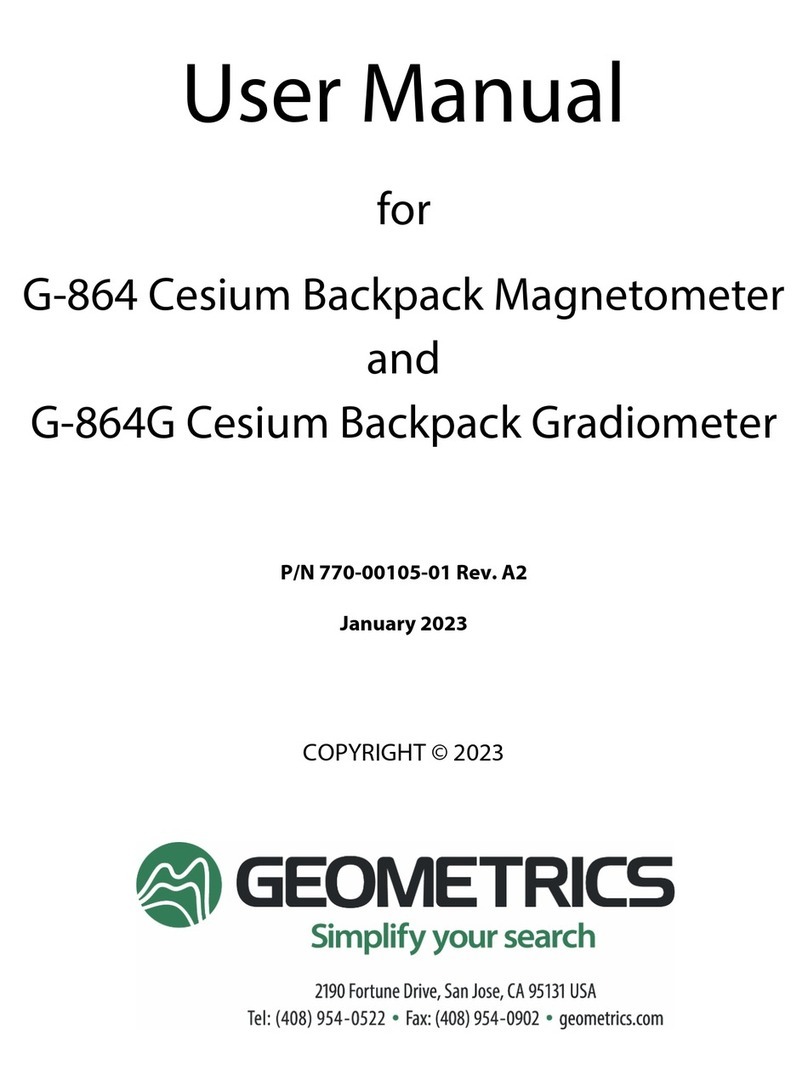
Geometrics
Geometrics G-864 User manual
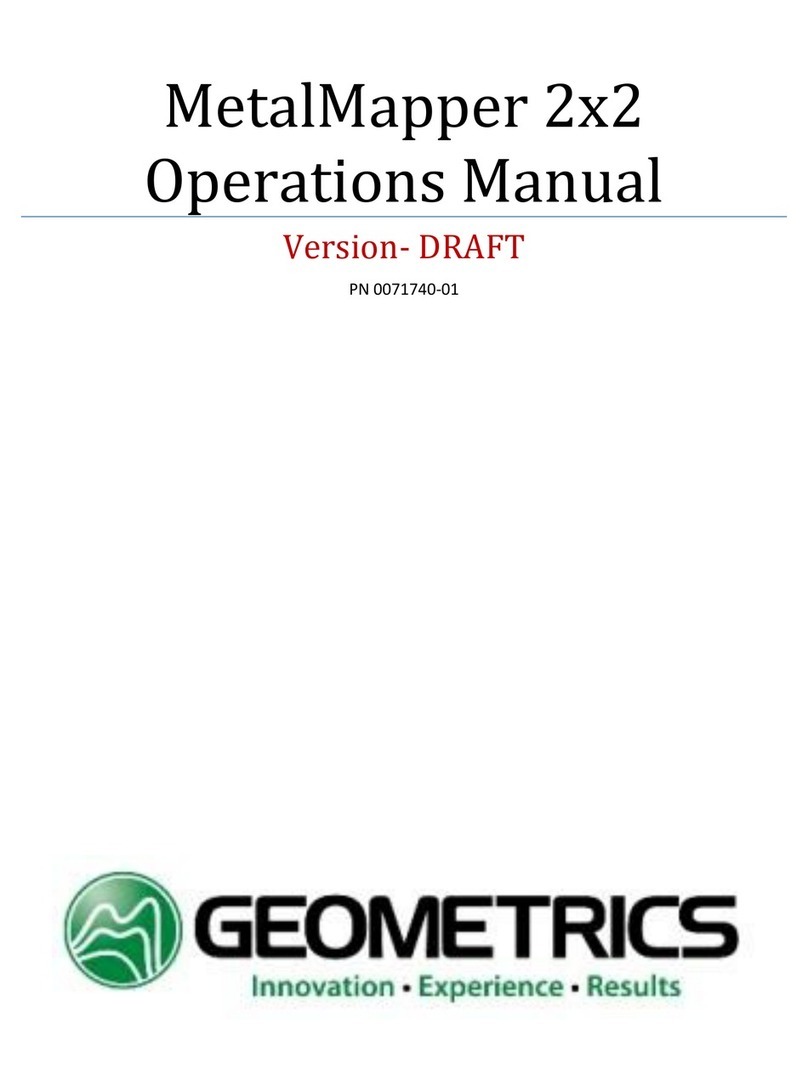
Geometrics
Geometrics MetalMapper 2x2 User manual
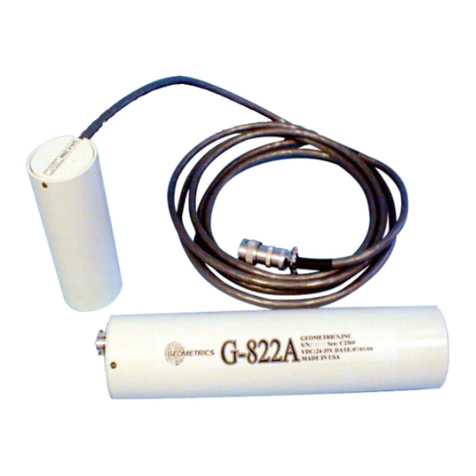
Geometrics
Geometrics G-822A User manual
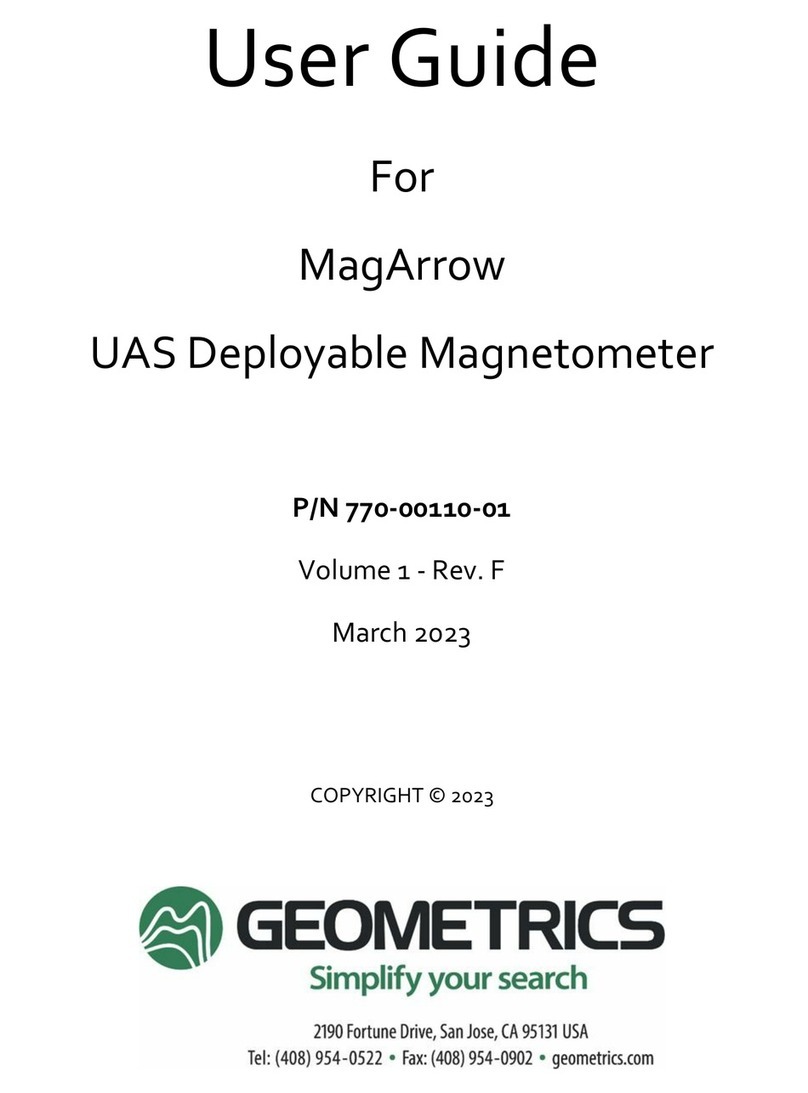
Geometrics
Geometrics MagArrow User manual
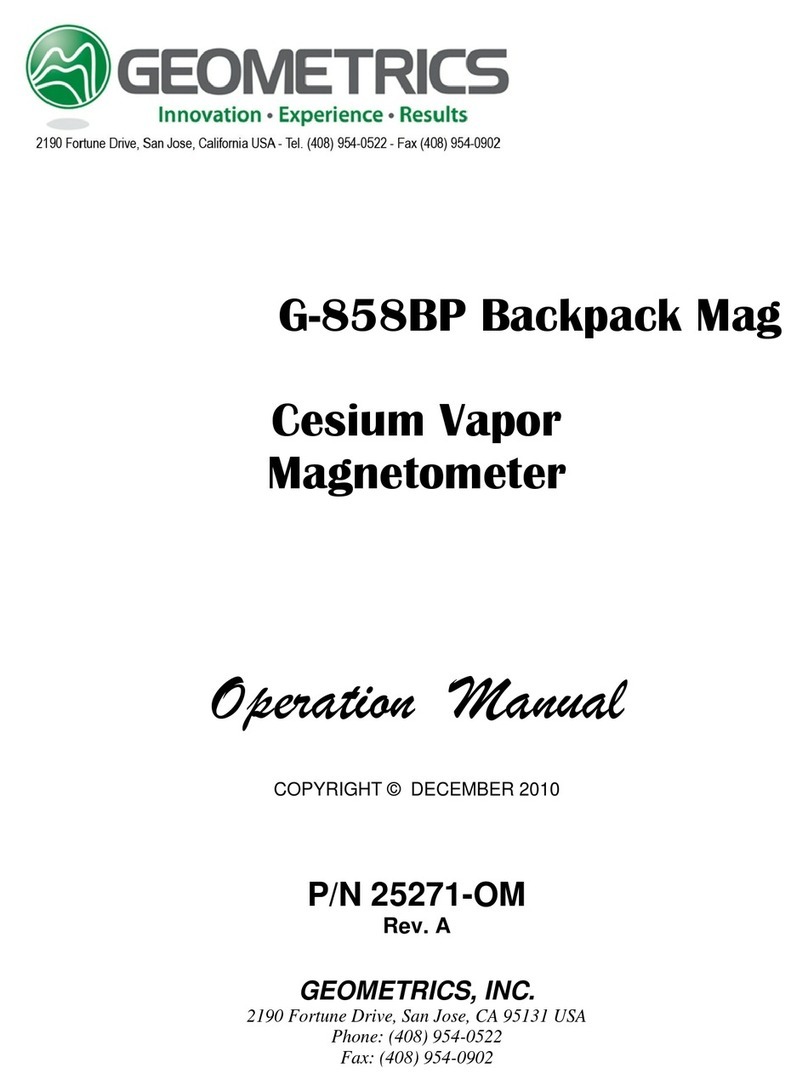
Geometrics
Geometrics G-858BP User manual

Geometrics
Geometrics MetalMapper 2x2 User manual
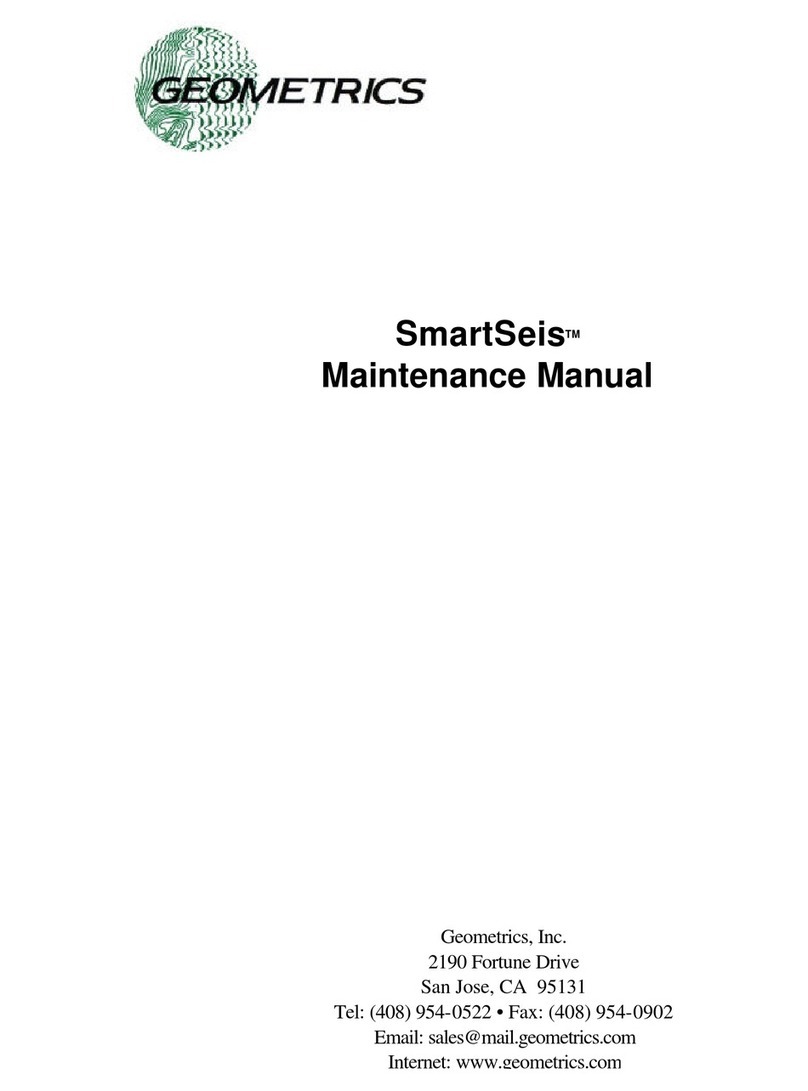
Geometrics
Geometrics SmartSeis User manual

Geometrics
Geometrics Memory-Mag G-857 User manual
